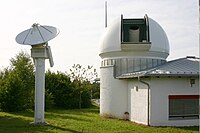
Photo from wikipedia
We present a method to estimate geocenter motion through single low-earth orbiter (LEO) precise orbit determination (POD) using global positioning system (GPS) tracking data and accelerometer data from the GRACE… Click to show full abstract
We present a method to estimate geocenter motion through single low-earth orbiter (LEO) precise orbit determination (POD) using global positioning system (GPS) tracking data and accelerometer data from the GRACE satellites. We fix the values of the GPS ephemerides and time-varying clock offsets to precise estimates from the definitive constellation product produced by the Jet Propulsion Laboratory. As part of the POD process of the LEOs, we estimate a translation of the reference coordinate system realized by the GPS orbit and clock product. Doing so accounts for the inconsistency between the Earth’s center of mass coordinate system used for the orbit integration of the LEOs, and the terrestrial reference frame produced by the GPS orbit and clock product. The resulting translation parameters estimated separately from the GRACE-A and GRACE-B satellites show very similar variations from day to day. They represent the geocenter motion, as realized from the difference between the origin of the terrestrial reference frame represented by the GPS orbit and clock product and the Earth’s instantaneous center of mass defined by the GRACE satellite dynamical orbital motion. Comparisons with geocenter motion observations from other techniques show that our daily estimates of geocenter motion agree well, when smoothed, in both the amplitude and phase of the annual signal. This validates both the high sensitivity of the GRACE GPS measurement type to geocenter motion and the high precision of the GRACE force model enabled by accelerometer measurements, the two essential components for estimation of geocenter motion with this technique.
Journal Title: Journal of Geodesy
Year Published: 2019
Link to full text (if available)
Share on Social Media: Sign Up to like & get
recommendations!